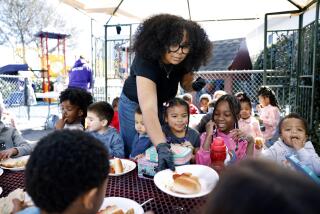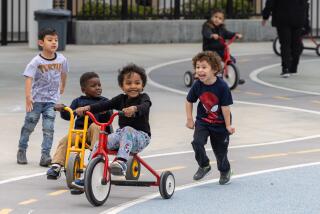‘Once People Use Us, They Can’t Live Without Us’ : ‘Sniffles Centers’ Send Parents Off to Work When Their Children Are Ill
- Share via
FAIRFAX, Calif. — There are pictures, puzzles and pills in a very special section of a 115-child day-care center where moderately ill youngsters of working parents get cuddled and comforted.
LeAnne Tom-Diaz’s son, Anthony, 2, has been in the Get Well Room twice with cold symptoms. Penny Clark’s son, Riley, 2, went with the flu.
The women, both single parents, said that without the child-care program at the center, they and others like them would be forced to miss work, possibly with loss of pay.
“You’d either have to take off work or find a baby sitter, which is nearly impossible,” said Tom-Diaz, a legal secretary. “This way, if your child has a common cold, they’ll take him in the Get Well Room. It’s great.”
Government Aid
The service at the Fairfax-San Anselmo Children’s Center in Northern California’s Marin County is one of more than a dozen “sniffles centers” that have opened up around the nation in the last couple of years. Most are funded by grants or government agencies, with parents paying part of the fee.
In an age when 20.6 million mothers with children under age 18 are in the work force and 8.6 million of these have children under age 6, even a mild illness can become a source of anxiety when it comes to finding alternative child-care arrangements.
A recent study by Work-Family Directions at Boston’s Wheelock College said 29 states require that day-care centers exclude sick children and 16 states require that family day-care homes exclude them. Fifteen states permit day-care programs to provide for sick children under certain guidelines.
“It’s definitely a national issue,” said Ethel Seiderman, director of the Fairfax center where regular programs include daylong infant and preschool care and after-class activities for children up to third grade. “There’s not a lot of understanding by employers if people stay home with a sick child.”
Although there are no government statistics on the amount of time missed or money lost due to such child-care problems, there have been some informal surveys. A 1985 study by the Service Employees International Union Local 715 in San Jose showed that 60% of its members stayed home when a child was sick, 19% said their spouses stayed home, 13% said relatives cared for the child and 8% relied on a child-care provider.
Seiderman said the Get Well Room, funded by a foundation grant, is free to any child at the center suffering from a low-grade fever, cold symptoms or other minor illnesses. A staff aide cares for up to six children a day, occasionally giving mild medications with parental permission. Children with fever over 102 degrees or with infectious diseases like chicken pox are not accepted.
“Because the child already knows the center environment, it’s no great leap to go to the sick-care room,” Seiderman said.
Providing a similar service to an entire community is Chicken Soup in downtown Minneapolis. Started a year ago with a $100,000 grant from the U.S. Department of Health and Human Services and $160,000 from local businesses and corporations, the center is in the process of adjusting its $30-a-day fee in order to assist low-income and single-parent families.
“We’re about to go on a sliding scale, which should attract more people to the center,” said Alberto (Birdie) Johnson. She said the state-licensed center has space for 27 children in three separate sickrooms, but that usually there are only five or six youngsters there on any given day.
Chicken Soup caters to children 6 months to 12 years old and has a Popsicle Room for those with tummy aches or stomach flu, a Sniffles Room for those with colds and a Polkadot Room reserved for chicken pox. Each area is self-contained. The Polka Dot Room even has a separate heating and ventilation system and a separate entrance.
‘They Come Back’
“Once parents use us, they come back,” said Johnson, who employs a nurse to screen incoming children. “There’s a real need for this kind of care in a quiet home-like environment.”
A recent study of Chicken Soup by state health officials, Johnson said, concluded that there has been no transmission of disease among children who attended the center, which does not take children with ailments like measles, strep throat or mumps.
At Sniffles ‘n’ Sneezles in North Miami Beach, some parents are so desperate for care for their sick children that they drive up to 40 miles to drop children off at the hospital-based center, according to director Mary Rosen. In fact, a twin infirmary, called Paw Meadows, has just opened 20 miles away in the western section of Florida’s Dade County.
“We get people from as far away as Fort Lauderdale and other counties,” Rosen said. “They feel guilty about having to leave a sick child and want the best care that is possible.”
Open year-round, Sniffles ‘n’ Sneezles accepts only children with mild illnesses to an unused hospital floor of the Southeastern Medical Center for a fee of $20 a day. A nurse is on duty, children can use the hospital beds and cribs to rest and meals are prepared from the facility’s kitchen.
“Once people use us, they can’t live without us,” Rosen said.
Studies have shown that infants and young children develop between six and nine viral infections a year, each lasting three to seven days.
One program that has pioneered helping mildly ill youngsters at a nearby day-care facility and from the surrounding community is the San Juan Bautista Child Development Center in San Jose.
Sliding Scale
With financial assistance from United Way, the City of San Jose and some corporate sponsors, the sick child care unit of the center, which supervises 300 children, charges parents on a sliding scale from zero to $20 a day.
“We’re the only ones who provide this kind of care,” said sick care supervisor Angela Camet. “We’re center-based but will take in children from the outside.”
The unit has a darkened nap room with beds and cribs and a brightly lighted, baby-blue day room with tables, games and toys. Meals are prepared at the day-care center, a nurse checks all incoming children and the director is a registered nurse.
“Children are scared to death of hospitals where the nurses are usually dressed in white and aren’t geared to keeping the youngsters occupied,” Camet said. “Most of the kids are up, active and want to play.”
She said six or seven children use the unit daily, with the average stay being two to three days. Of parents who use the facility, 85% are female heads of households, Camet said, and 80% are low-income. Two single fathers have used the unit, which spends $35 daily for each child admitted.
Other center-based or infirmary sick-child-care programs include the Colorado Springs, Colo., Child Nursery Centers; Wheezles ‘n’ Sneezles day-care center in Berkeley; Grandma’s House in the Hi-Hello Day Care Center in Freeport, N.Y., and Kid Care in the pediatrics unit of St. Mary’s Medical Center in Racine, Wis.
Home Care Programs
There are also about two dozen programs around the nation that provide care for sick children in their own homes. One of the most successful models is the Tucson Sick Child Home Health Care Program used by 1,400 families last year.
Under the 7-year-old nonprofit program, available to the community and used by eight major employers including the City of Tucson, aides are given 150 hours of training in skills ranging from simple nursing techniques to arts and crafts and are on call to care for sick children in the family’s home.
“During the flu season we might have as many as 15 or 16 aides out and have to turn away people,” said executive director Martha Rothman, who operates a 24-hour hot line for parents needing help for sick children ranging from infancy to their mid-teens. “On a nice summer day, maybe nobody has to be sent out.”
She said that the agency spends $7.85 an hour for each sick child they care for and that United Way and the Arizona Department of Economic Security help fund the program. The maximum hourly charge for a family in the $60,000 earning bracket, she said, is $5.25. The lowest income families pay only $1.50 an hour.
The resource and referral agency, administered by the Tucson Assn. for Child Care Inc., is also consulting with the area’s largest hospital, the Tucson Medical Center, on setting up a sick-child-care room for use by hospital employees. The room for ill children, she said, could eventually be expanded to include the outside community.
Some Firms Pay Cost
“We feel strongly about the need for this project,” Rothman said of the model in-home program. “Some parents can take a day or two of their sick time to care for an ill child, but a third day can be very difficult. We have some firms that happily pay the whole cost of our service for their employees because they’d rather have them in the office than at home.”
Most big cities are still struggling with the problem of providing basic child day care, an issue that has only recently gained public acceptance because of the growing number of middle-class and two-income families needing such service. This leaves the need for sick-child care on the sidelines.
Karen Furia, head of the San Francisco mayor’s office on child care, said that a community development team has looked into care for ill children but that any program is far in the future.
“It’s something people talk a lot about, but it would take a lot of study, time and money,” Furia said. “Our concern right now is to create a healthy and safe environment in existing child-care centers. Quality sick-care centers may be further down the road.”
Judy Calder, coordinator of health services for Bananas, an Oakland-based child-care referral center, said companies need to support such centers as Wheezles ‘n’ Sneezles in Berkeley, which accepts youngsters from the Albany Children’s Center and also has an in-home program available for fees ranging up to $4.50 an hour.
“Sick-child care is an issue that has come about as a result of the influx of infant-toddlers into the child-care system over the past seven years,” Calder said. “These centers say its OK for kids to get sick, OK for parents to continue working when they do get sick and that their community supports them when it happens.”
‘There’s not a lot of understanding by employers if people stay home with a sick child.’
More to Read
Sign up for Essential California
The most important California stories and recommendations in your inbox every morning.
You may occasionally receive promotional content from the Los Angeles Times.










